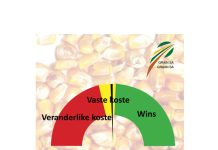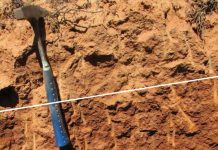Soil is the most fundamental resource for the farmer, without which food and natural fibre cannot be produced. The mineral fraction of soils originates mainly from geological material. This article aims at highlighting the primary and non-silicate minerals. These minerals occur to a greater or lesser extend in soil and influence the soil’s chemical and physical properties substantially.
Primary minerals form when rocks weather physically and the minerals are released chemically unchanged from the parent rock. The primary minerals are further subdivided into two groups, the silicate and non-silicate minerals.

The silicate minerals
The silicate minerals comprise a basic silicon (Si4+) tetrahedron, which forms when the Si4+ cation is surrounded by four oxygen (O2-) anions to form SiO4 4-. Various combinations of this and other elements (primarily cations) which bind themselves to this, form the various silicate minerals.
Olivine
When the negative charge on the SiO4 4- is balanced by iron (Fe2+) and magnesium (Mg2+) cations, olivine is formed (Figure 1a). Olivine ((Mg,Fe) SiO4) is rather unstable in soil and weathers rapidly to release Fe2+ and Mg2+ into the soil.
The pyroxene group
The pyroxene minerals form when the Si tetrahedra arrange themselves together in a single chain (Figure 1b). The basic unit of the single chain is SiO32- and the negative charge is balanced by calcium (Ca2+), Fe2+ and Mg2+. The pyroxenes, with augite (Ca(Mg,Fe)Si2O6) as the most common mineral in this group, are hard but, as a result of the long chain structure, they weather rapidly to release Ca2+, Fe2+ and Mg2+cations into the soil.
The amphibole group
When two tetrahedral chains bind together to form a double Si tetrahedral chain, the amphibole group is formed (Figure 1c), with Si2O5 2- as the basic unit. Once again the negative charge of the chain is balanced by Ca2+, Mg2+, sodium (Na+) and Fe2+. Hornblende [(Ca,Na,K)2(Mg,Fe, Al)3(Si,Al)8O22(OH)2] is the most common amphibole. Amphiboles occur widely, especially in young (more recently formed) soils.
The mica group
A plate of Si tetrahedra forms one of the most basic building blocks of the mica group of minerals (Figure 1d). These minerals constitute a very important group in soil and will be discussed as fine micas in the next article in this series.
The feldspar group
The feldspar minerals (Figure 1e) are framework silicates, with SiO2 as basic unit, in which isomorphic (the same shape) substitution takes place, during which Al3+ replaces some of the Si4+. The negative charge is balanced by Ca2+, Na+ and potassium (K+). That gives rise to the Ca, Na and K feldspars, namely Orthoclase (KAlSi3O8) which is a potassium feldspar, Albite (NaAlSi3O8) which is a sodium feldspar and Anorthite (CaAl2Si2O8) which is a calcium feldspar. Plagioclase is a feldspar in which Ca2+ and Na+ can be found in various ratios. The feldspar minerals are relatively unstable, weather relatively easily and thus occur in small quantities in soil. During weathering, they provide the soil with Ca2+, Mg2+ and Na+ respectively.
Quartz
The final primary silicate mineral is quartz (Figure 1f). Quartz is also a framework silicate, with SiO2 as its basic unit, but it has little isomorphic substitution. Therefore, it has virtually no negative charge that has to be balanced by cations. Quartz is therefore very hard, weathers very slowly and releases virtually no basic cations during weathering. Because quartz is resistant to weathering, it occurs abundantly in the soil, where it makes up the largest portion (as much as 90%) of the sand fraction. In the soil, quartz is usually colourless or milky white, but is often covered with a layer of red or yellow iron oxide, giving the soil a red or yellow colouring. As quartz has no cations, it contains no plant nutritive matter and is therefore chemically non-reactive and therefore mainly plays a role in the physical properties of soil.

Figure 2: The black mineral is hornblende and is part of the amphibole group.
Figure 3: The pink mineral is orthoclase and is part of the feldspar group.
From the above, it can be seen that there is a decrease in the negative charge, and therefore fewer complimentary cations, as the Si minerals become more complex (from top to bottom in Figure 1). The minerals therefore become increasingly more stable and release increasingly less cations into the soil during weathering. One can therefore say that the minerals increasingly become more acidic (with less basic cations).
The non-silicate minerals
The non-silicate minerals do not contain silicon in the mineral structure and can be sub-divided into the oxides and hydroxides, the carbonates, bicarbonate, sulphates, sulphides, and chlorides of Ca, Mg, and Na. The majority of non-silicates are soluble in water, while the silicate minerals are insoluble. The non-silicate minerals thus play an important role in the chemical properties of the soil.
Oxides and hydroxides
Hematite (Fe2O3), goethite (FeOOH), magnetite (Fe3O4), gibbsite (Al2O3) and boehmite (AlOOH) are the most important oxides and hydroxides. The oxides make up a small percentage of the soil. Iron oxide usually occurs as thin layers on quartz crystals and, in so doing, gives the soil its distinctive red or yellow colouring. The iron oxides are relatively insoluble in water, but under long-term saturation in water, the iron can be reduced and becomes soluble. This makes iron, and therefore the soil colour, a useful tool to deduce water saturated conditions. Iron oxides can also accumulate in the soil under conditions of a fluctuating water table. Under these conditions, the iron oxides are localised into mottles which, under long-term accumulation, can harden to form an ironed layer – the so-called ferricrete. The Al oxides are seen as the end product of weathering and are thus only present in very old soils and under conditions of intense weathering and leaching. Both Fe and Al oxides can precipitate with phosphate under low pH conditions, making it inaccessible to plant uptake.
Carbonates and sulphates
The dominant minerals in this group are lime (CaCO3), gypsum (CaSO4), magnesite (MgCO3) and MgSO4. The sulphates are highly soluble, but the carbonates are slowly soluble and are usually leached out of the soil where the rainfall is more than 550 mm per annum. They are therefore mainly found in the soils of arid areas and in irrigated soils, where it is added to the soil via irrigation water. In arid areas, the lime and or gypsum can accumulate in the soil as a continuous soft or hard layer. Calcitic and dolomitic lime and under certain circumstances gypsum, are also used to increase the basic cation content and the pH of the soil.
Phosphates
Apatite [(Ca3(PO4)2)3•Ca(Cl,F)2] is a phosphate mineral which comprises <1% of igneous rocks. However, apatite weathers slowly and is the primary source of natural phosphate as plant nutrient in soil.
Summary
To summarise, quartz is the most dominant silicate soil mineral, followed by the micas, feldspars, amphiboles, pyroxenes and olivine. The non-silicate minerals are usually soluble in soil and thus occur mainly in arid regions. The iron minerals are responsible for the red and yellow colour of soils and may also be used as an indicator of the water regime of soils. The Ca and Mg carbonates are mainly used to neutralise soil acidity.
For further information, please contact Martiens du Plessis at 072 285 5414 or martiens@nwk.co.za or Cornie van Huyssteen at 051 401 9247 or vanhuysteencw@ufs.ac.za.
References
The following references were used extensively during the compilation of this series of articles:
- Brady, NC. and Weil RR. 2002. The Nature and Properties of Soils. 13th ed. Prentice Hall: New Jersey.
- Van Huyssteen, CW. 2009. Soil ecology. Unpublished class notes for GKD214. University of the Free State: Bloemfontein.

















